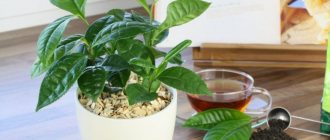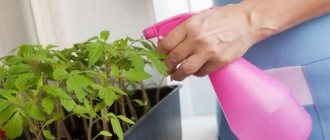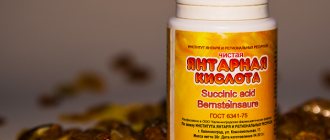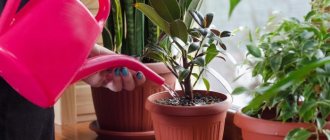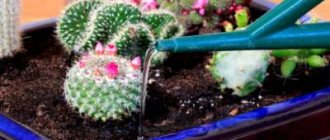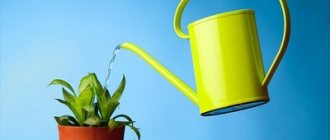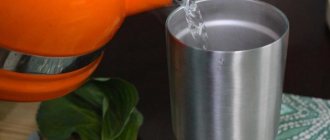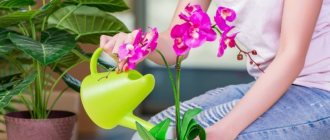- Safety precautions when working with potassium permanganate.
- Useful properties of potassium permanganate.
- The use of potassium permanganate for the prevention of infections and their treatment.
- Potassium permanganate against parasites and pests.
- Potassium permanganate to stimulate root formation of cuttings and seeds.
- Potassium permanganate as a fertilizer for indoor plants.
- Symptoms of potassium and manganese deficiency are:
- The recipe for fertilizer with potassium permanganate is as follows:
Potassium permanganate (chemical formula KMnO4) or, as people often call it, potassium permanganate has been known for quite a long time and was used in the household by our grandmothers and mothers. Potassium permanganate was used for various purposes - it was used to make baths for newborns, wash wounds, treat the stomach, and even stain wood. However, if at present more modern means and methods can be used for all of the above, then for floriculture, a solution of potassium permanganate is still the most common and at the same time no less effective remedy .
When certain substances interact with potassium permanganate, it becomes activated and can explode. Therefore, you must be careful when working with potassium permanganate.
Safety precautions when working with potassium permanganate.
Important! A highly concentrated solution of potassium permanganate, as well as undissolved crystals, can cause severe chemical burns.
- Do not allow potassium permanganate to interact with any other substances, especially aluminum, magnesium, phosphorus, etc. to avoid fire and explosions.
- Avoid direct contact with skin as potassium permanganate stains and dries the skin.
- Wear rubber gloves when handling the solution.
Important! If crystals get on your skin, try not to wash them off with water, but remove them with a dry cotton pad. Only after completely removing the crystals from the skin can you rinse the infected area with water and lubricate it with a rich cream.
Precautionary measures
The manganese solution contains a high concentration of active components, so when using it it is necessary to protect the skin and mucous membranes. If the product gets on the skin surface, wash the affected area under running water and soap.
When processing plants, it is important to follow the dosage so as not to harm the leaves, shoots and root system. During application, you should protect yourself with rubber gloves and wear protective clothing to protect exposed areas of the body from accidental contact with the solution.
Sources:
https://floristics.info/ru/preraraty/fungitsidy/5424-margantsovka-kak-primenyat-ot-chego-pomogaet.html https://udobreniya.pro/margancovka-kak-udobrenie-primenenie-dlya-ogoroda-i -sada-dlya-rastenij-tomatov-ogurcov/ https://superurozhay.ru/mineralnye-udobreniya/margancovka-kak-udobrenie-dlya-rastenij.html
The use of potassium permanganate for the prevention of infections and their treatment.
When replanting houseplants, you can use a solution of potassium permanganate. also used to disinfect indoor plants . It is suitable both for watering the soil as a preventive measure for fungal infections , and for treating roots, bulbs and tubers infected with rot .
Potassium permanganate saves from rot.
In the first case watering is carried out with a more concentrated solution of potassium permanganate (wine-colored), in the second case, both a weak (pale pink) and medium concentrated (pink) solution of potassium permanganate is used. When replanting a plant, carefully examine its underground organs. If the plant is completely healthy, then for prevention, even healthy roots, tubers, and bulbs can be soaked in a weakly concentrated solution for 15-20 minutes. In the case of an infected plant, the rotten roots are cut back to healthy tissue and soaked in a medium concentrated solution of potassium permanganate for the same time.
Important! When a plant is infected with rot, the pot, and especially the soil, is also infected. When planting a plant, be sure to treat the pot with a soap solution (using laundry soap), pour boiling water over it, and preferably use new soil.
Application area
Growing seedlings, greenhouse and perennial plants must be done correctly. Otherwise, the time spent on planting and care will be wasted. Potassium permanganate is widely used as a fertilizer and protection. It is actively used as:
- antiseptic;
- disinfectant;
- growth enhancer;
- protective and prophylactic substance.
As a fertilizer for plants
Watering with potassium permanganate is possible with other fungicides as an enhancer of their capabilities. Manganese can be added both before sowing and after planting, during growth. In combination with boric acid, it ensures the active production of chlorophyll, ascorbic acid and fructose, which is extremely important for improving the taste of fruits.
It makes no difference what it was used for, since an obvious improvement will occur both in vegetable crops and fruit and berry crops (raspberries, strawberries, currants, gooseberries).
Potassium permanganate against parasites and pests.
It is believed that a solution of potassium permanganate not only disinfects and disinfects, but also helps in the fight against insect pests. There is a deal of truth in it. My experience shows that potassium permanganate can be used in combination with other pest control agents , but do not rely on it alone, since potassium permanganate is not a poison for most insect pests .
Potassium permanganate alone will not help you cope with insect pests.
Will potassium permanganate help against midges? No - you cannot remove flying insects from your plant using potassium permanganate alone. Use special insecticides for this. To combat insect pests, I advise you to use ready-made preparations Fufanon and Actellik.
Spraying
There is no point in spraying the plant . After all, if there is not enough magnesium and potassium, you need to start feeding the plant. Frequently spraying the leaf can cause the leaf blade to dry out and cause unsightly spots to appear on it that will not disappear. When harmful insects appear, it is better to start wiping the leaves to remove their waste products.
Potassium permanganate to stimulate root formation of cuttings and seeds.
When propagating indoor plants by seeds or cuttings , you can also use potassium permanganate. The seeds are soaked for 30-40 minutes in a weak solution of potassium permanganate and then planted in the ground. In this case, you kill two birds with one stone - you disinfect the seeds and stimulate their germination . Cuttings can also be soaked in a solution of potassium permanganate for faster root formation . You can replace potassium permanganate with Kornevin .
Reasons for treating the land with potassium permanganate
One of the factors contributing to the proper growth and development of plants is soil disinfection. There are several reasons to cultivate the land:
- soil pathogens of fungal diseases and various infections are destroyed. Fungi that infect the above-ground parts of plant crops can move into the soil, where they develop safely, causing harm to plants;
- restoring the balance of earth microflora. Without the necessary treatment, pathogenic microorganisms (mold, fungi) may predominate in the soil, negatively affecting plant development;
- protection of root crops from wireworms and various types of flies.
In beds with soil treated with potassium permanganate, plants take root faster and absorb nutrients more actively. Thanks to this, productivity increases.
Potassium permanganate as a fertilizer for indoor plants.
How can you tell if your houseplant is lacking potassium or manganese?
Symptoms of potassium and manganese deficiency are:
- twisting the sheet plate along the edge
- yellowing of leaf tips
- pale leaves
- chlorosis
Diagnosis of plant micronutrient deficiency.
The recipe for fertilizer with potassium permanganate is as follows:
- boric acid 1/3 teaspoon
- potassium permanganate on the tip of a toothpick
- 3-5 drops of iodine
- 3 liters of water
Boric acid must be dissolved separately in warm water (40-45 degrees), until the crystals are completely dissolved. potassium permanganate in a prepared container in 3 liters of water until a pale pink color is obtained . Then add 3-5 drops of iodine . And lastly, add dissolved boric acid . With this solution it is necessary to carry out both root and extra-root feeding of domestic plants.
Important! Fertilizing should only be done on watered plants; it is not recommended to apply fertilizing to dry soil.
A solution of potassium permanganate allows you to compensate for the lack of microelements such as potassium and manganese. In addition, it has a beneficial effect on fruiting indoor plants, such as pomegranate, persimmon, citrus fruits (lemon or orange). But an excess of microelements can lead to undesirable consequences . Therefore, do not abuse this substance.
Basics of using manganese solution for plant nutrition
Potassium permanganate, or as it is often called, potassium permanganate, is a well-known antiseptic and disinfectant, widely used for household and medical purposes. But in addition to this, a solution of potassium permanganate has also found its use in gardening. Let's consider the need for manganese for plants, its use as a means of protection against diseases and pests, as well as fertilizer.
What are the benefits of potassium permanganate for plants?
The influence of manganese on plants due to its disinfecting properties is primarily manifested in the prevention and control of fungal diseases, as well as some garden pests. In addition, the role of manganese in plant life is to provide organisms of various crops with the microelements they need.
For what purposes is manganese used in the garden?
Manganese is used in the garden and vegetable garden in the following areas:
- disinfection of soil, planting material, and garden tools;
- control of certain garden pests;
- protection of crops from infectious diseases;
- fertilizing plants to improve their development.
Potassium permanganate is widely used for household and medical purposes.
Treatment of soil and seeds before planting
Before sowing seeds for seedlings, it is recommended to pour the soil generously with a particularly strong mixture, for the preparation of which 1 g of potassium permanganate particles is dissolved in 2 liters of hot water (about 70º).
Before sowing, the seeds themselves should also be soaked for 25 minutes in a strong solution of potassium permanganate, which is prepared in the proportion of 2 g of crystals per 1 liter of warm water. After this, the seeds are thoroughly washed in running water and dried.
Disinfection of garden tools with manganese
Using such an inexpensive product as a saturated solution of potassium permanganate, you can disinfect garden equipment. Particular attention should be paid to cutting tools: pruners, scissors, knives, saws, axes. It is recommended to treat them before each use, especially if you have previously worked with diseased plants.
Potassium permanganate against pests
The use of manganese to protect plants from pests also gives good results:
- wireworm damaging root crops;
- flies of different types;
- slobbering pennies threatening strawberries.
In the first two cases, you can get rid of pests if, before planting, you spill the soil with a saturated solution of potassium permanganate (5 g of the substance per 10 liters of water), and also soak the seeds and tubers. To destroy the strawberry pest, it is enough to pour hot (about 65º) hot (about 65º) potassium permanganate with a bright pink consistency. Such hot washes carried out in the evening are useful for bushes at any stage of their development. Only for young bushes the temperature should not be higher than 45º.
You can disinfect gardening equipment using such an inexpensive product
Control of plant diseases
Potassium permanganate is also effectively used both for the prevention and treatment of fungal viruses in cultivated plants.
Late blight or late blight
Late blight mainly affects nightshade crops. For preventive purposes, it is recommended to generously spray tomato, pepper, eggplant and potato bushes with a special medicinal solution every two weeks: take 2-3 g of potassium permanganate crystals and a glass of squeezed garlic into a bucket of water. The mixture is left to stand for 3-4 hours, filtered and 2 tablespoons of liquid soap are added to it so that the solution sticks to the plants.
Powdery mildew
Unfortunately, powdery mildew is known to many gardeners and gardeners. It affects strawberries, currants, raspberries, other berry bushes and fruit trees, cucumbers and other melons, as well as flowers. At the first symptoms of the disease, it is necessary to dilute a bright pink solution of manganese and generously spray all affected parts of the plants. Treatment should be carried out 3-4 times every 5 days.
Gray rot
A fungal plant disease such as gray rot most often affects strawberries, grapes, raspberries, cabbage, and onions. To protect crops from this fungus, you can also use sprinkling with a solution of potassium permanganate. In spring, you should use a pale pink mixture (2 g per bucket of water), and before setting fruit, it is recommended to use a more saturated consistency (1 g of substance per liter of water).
To prevent plants, it is effective to use a solution of potassium salt
Blackleg
A solution of potassium salt of permanganic acid can also actively fight blackleg, a disease that often affects vegetable seedlings, and sometimes adult tomato bushes, cabbage, and flowers. For prevention, it is recommended to water the seedlings at the root with a slightly pink mixture of potassium permanganate. When a disease appears, the damaged plant must be removed along with a layer of soil, add ash or sand and generously spill the soil with a saturated solution of potassium permanganate.
Accelerating berry set
When growing berry bushes and plants, for example, currants, gooseberries, strawberries, the following nutrient mixture can be used to activate fruiting: 2 g of potassium permanganate crystals and 2 g of boric acid, as well as 200 g of ash cleared from debris, are added to a bucket of water.
Use as a top dressing
Permanganic acid is also recommended for use as a feed for crops lacking magnesium and potassium. Feeding plants with manganese stimulates the development of the root system, the production of necessary sugars and acids, and the setting and ripening of fruits. It plays an important role in photosynthesis and respiration of plants, and improves their immunity.
The main thing to remember is that you should not overdo it with fertilizers, since an excess of manganese in plants will damage them no less than its deficiency. In addition, it is necessary to strictly observe the proportions when preparing the solution, since a stronger concentrate will lead to burns and death of crops.
It is recommended to use permanganic acid as a feed for crops.
Main symptoms of manganese deficiency
Manganese deficiency in plants manifests itself in the following signs that you need to pay attention to:
- yellowing of leaves between the veins and at their base;
- the appearance of yellow spots and dots on the leaves, which over time turn into light yellow necrotic spots;
- leaf dying.
Sugar beet roots
For the development of sugar beet roots, foliar fertilizing with a solution of potassium permanganate has a good effect. They can be carried out several times a season by watering the tops or spraying. The mixture is prepared at the rate of 5 g of substance crystals per bucket of water (10 l).
Potato
In mid-summer, it is effective to feed potatoes with a solution of potassium salt of permanganic acid. To do this, dissolve 3 g of crystalline powder in 10 liters of water.
What plants tolerate the use of potassium permanganate well?
The answer is obvious - those that feel good in slightly acidic and acidic soil . These plants include : abutilon, alocasia, amaryllis, asparagus, aspidistra, azalea, anthurium begonia, gardenia, hydrangea, diefenbachia, kalanchoe, calathea, kala, camellia, clivia, monstera, pelargonium, primrose, poinsettia, ivy, spathiphyllum, tradescantia, violet, ficus, fuchsia, chlorophytum, cyclamen, cyperus, shefflera.
It is very difficult to measure the exact dosage in milligrams, so if you focus on the color of the solution, you will never be mistaken.
Who is this watering suitable for?
Now let's take potassium permanganate as a whole substance, without breaking it down into its constituent elements. How will such a solution behave in the soil?
It slightly acidifies the soil. So, it is well suited for those plants that prefer acidic soil. It is in it that the absorption of manganese is maximum. In alkaline soil, poorly soluble compounds of this element are formed, which are poorly absorbed by plants.
Plants that prefer acidic soil most often came to us from the tropics:
- begonia,
- gardenia,
- hydrangea,
- dieffenbachia,
- fern,
- poinsettia,
- tradescantia,
- Cyperus.
As you understand, the list is far from complete; I have given only a few names as examples. Complete information on such plants can be easily found on the Internet. I honestly can’t say anything about garden plants and trees, I’m not interested in it. If anyone is interested, then maybe this will help you.
In addition, citrus fruits, violets, pomegranates, and peppers feel good when watered with a permanganate solution. I wish I had known about this when I was growing my cute purple peppers.
Diluting a solution of potassium permanganate for watering flowers.
Potassium permanganate crystals must be completely dissolved in water.
There is no point in diluting large volumes of potassium permanganate at home, so the best option for us would be 1-2 liters. Potassium permanganate dissolves better in warm water , so you need to prepare a container with warm water (30-40 degrees) in which you will directly dilute the solution. And a container in which you will regulate the concentration of the substance. For breeding in warm water, a small bowl will suit you. Wet the tip of a toothpick and dip it in potassium permanganate. The required amount of crystals will stick to the tip, and we begin to dilute them in warm water. For now we don't care about concentration. After the crystals have completely dissolved, you can pour our solution into a two-liter container, adjusting the concentration of the solution by adding the required amount of water.
Important! Potassium permanganate crystals must be completely dissolved in water; getting undissolved crystals on the roots or foliage of a plant can lead to severe chemical burns.
What is potassium permanganate?
In everyday life, potassium permanganate is the potassium salt of manganese acid, which is designated by the chemical formula KMnO₄. The second more common chemical name for the substance is potassium permanganate.
In industry, manganese is extracted from manganese ores, and salt is obtained by chemical or electrochemical oxidation of manganese compounds.
In appearance, potassium permanganate is a beautiful dark purple or almost black crystals that dissolve in limited quantities in water.
How to prepare a 1% solution of potassium permanganate?
To obtain a 1% solution of potassium permanganate, you need to dilute 1 gram of the substance in 100 ml of water. To obtain a 2% solution, respectively, 2 grams. But summer residents, as a rule, make such solutions “by eye”. Which may not be entirely accurate, but you don’t need to purchase ultra-precise scales.
To do this, use a standard teaspoon. If you pour potassium permanganate crystals into it without the top (carefully remove the top with a knife blade), then 6 g of the substance will fit into it. After diluting this amount of potassium permanganate in 600 ml of water, we obtain a 1% solution of potassium permanganate.
Chemical properties of potassium permanganate
Potassium permanganate is a strong oxidizing agent. Soluble in water, ammonia, methanol, pyridine, acetone. Depending on the pH of the solution, it oxidizes various substances; in reactions it is reduced to manganese salts of varying degrees of oxidation.
The oxidizing properties of potassium permanganate provide antiseptic and antimicrobial effects. The chemical (from the group of “harmless” chemistry) began to be used by summer residents as a disinfectant and microfertilizer for fertilizing in vegetable gardens and berry plots.
Be careful with potassium permanganate! Use gloves when working with crystals. If they come into contact with the skin, they can cause dermatitis. Make sure that dust particles do not enter your respiratory tract. This may lead to a cough or headache.
Depending on the manufacturer, potassium permanganate on sale today can be in different packages. © stoporvi
How to determine the required concentration of potassium permanganate for indoor plants?
Weak, medium and highly concentrated solutions of potassium permanganate.
Everything is very simple. Also focusing on the color of potassium permanganate. A weak concentration is used for prevention and fertilization and is pale pink in color . A medium concentrated solution of potassium permanganate is used for soaking seeds and disinfecting roots/tubers/bulbs in the treatment of fungal diseases, rot and has a pink color. A highly concentrated solution of potassium permanganate is used to disinfect soil by watering and has a bright pink saturated color.
Important! The shelf life of such a solution is no more than two weeks.
How to water correctly
When using manganese, the main thing is to wait until its crystals are completely dissolved, and only then use it against midges, as a feed or against rot. Water the flowers with diluted potassium permanganate at the root, allowing the soil to dry out after the previous time. If midges have infested indoor crops, it is also recommended to adjust the frequency of moisturizing procedures.
Treating flowers with potassium permanganate against pests is a completely effective and affordable way to combat them. It is important to apply the pink solution in a timely manner and not allow excess moisture in the soil. To avoid burns, the concentration of dark purple crystals should not be exceeded.
Potassium permanganate, or as it is often called, potassium permanganate, is a well-known antiseptic and disinfectant, widely used for household and medical purposes. But in addition to this, a solution of potassium permanganate has also found its use in gardening. Let's consider the need for manganese for plants, its use as a means of protection against diseases and pests, as well as fertilizer.
How to prepare a 0.3% or 0.5% solution of potassium permanganate?
To prepare a 0.3% solution of potassium permanganate, you must maintain the following proportion - 0.3 grams of permanganate per 100 ml of liquid. Accordingly, a 0.5% solution of potassium permanganate is also prepared, only 0.5 grams per 100 ml is taken. However, I advise you to focus specifically on the color of potassium permanganate, as this will make it much easier to select the required concentration.
Unfortunately, at the moment it is possible to buy potassium permanganate only in state and municipal pharmacies, and in small dosages. Sometimes even with a prescription.
Soil disinfection using potassium permanganate
Over time, bacteria and fungi existing in it accumulate in the organic environment of garden soil - pathogens of gray rot, fusarium, powdery mildew, late blight and other diseases of cultivated plants.
When directly planting seedlings in the growing soil, a 2% aqueous solution of potassium permanganate is poured into the planting hole in a volume of 1 liter. In order for potassium permanganate to dissolve in it quickly and completely, the water for the solution should be heated to +70 C.
When such a hot solution comes into contact with cold ground, the temperature will become lower and will not harm the seedlings, although to be on the safe side it is better to pause for reliable cooling.
The same is done when disinfecting soil in greenhouses; in tree trunk circles, in the aisles of fruit and berry bushes, on the surfaces of flower beds. They begin such preventive treatment, as a rule, in early spring during the March work, having cleared the areas of such treatment from plant and other debris.

